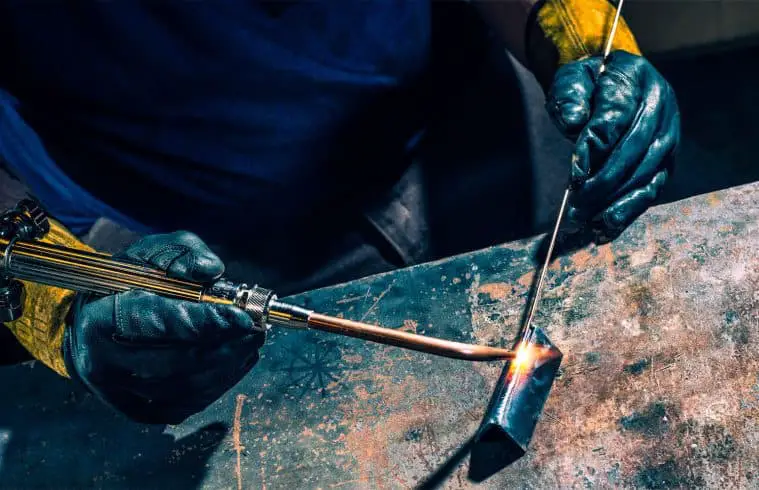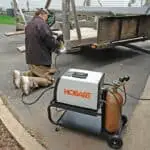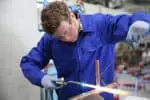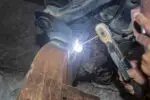Gas welding is a metal joining procedure that employs the utilisation of fuel gases, like gasoline and oxygen, to weld and cut metals.
It is also a metal joining procedure in which the edge pieces of a metal that need to be joined are heated at their interface by creating a blend using one or more gas flames such as oxygen and acetylene.
As a result, a powerful gas flame is created, which melts the edges of the welded components. The molten metal is allowed to flow to solidify together, resulting in a continuous connection.
There are various advantages and disadvantages of gas welding. Let us discuss them in detail.
But before we understand the advantages and disadvantages of gas welding, let us understand why gas welding is important.
→ Welding’s intense heat allows chemical reactions to occur far faster than they would otherwise, and also, rust and corrosion can occur when oxygen and water vapour in the air interacts with your fresh, hot weld bead.
This rust weakens the weld and reduces the quality and value of your product.
→ Welders utilise shielding gases to protect the weld from corrosion. The gas is forced via the electrode handpiece onto the hot weld bead, shielding it from corrosion during the critical few seconds when it is at its hottest.
→ Shielding gases have various properties. The ideal gas to use is determined by the metal you are welding, the technique you are utilising, and the demands of your project.
The following are some examples of common shielding gases:
CO2 (Carbon Dioxide)- This is the most affordable shielding gas available. CO2 is more effective on carbon steels.
Argon gas- Argon is more costly than CO2, but it can be used on a wider spectrum of materials. It is sometimes mixed with other gases to increase performance and save costs.
Argon is used in the production of stainless steel, aluminium, and other nonferrous metals.
Helium- Helium is an expensive gas, yet it provides the best heating and weld penetration. Helium is most commonly used for welding aluminium, copper, and other heat-dispersive metals.
Oxygen- To improve the operating properties of the weld pool, oxygen is occasionally added to weld gas mixtures.
However, it is only utilised at extremely low rates since oxygen is corrosive to metal, particularly when it is hot after welding.
Blend of gases- In certain cases, gas blends are utilised to make welding simpler, to assist the weld penetrate deeper, or to allow you to weld faster.
Advantages of Gas Welding
1.) It may be used to link a variety of metals: Welding ferrous and nonferrous metals together can be accomplished with gas welding. This is one of its most significant advantages over other welding procedures.
2.) It does not need electricity: When compared to other common welding technologies such as arc welding, gas welding does not require any power to operate. As a result, gas welding may be used in areas where power is not available.
3.) Improved Temperature Control: By modulating the gas flame, gas welding allows for more control over the temperature of the metal in the weld zone.
4.) Greater control over the rate of filler-metal deposition: Unlike arc welding, the source of heat and the filler metal are distinct in gas welding. This allows for greater control over the pace of filler-metal deposition.
5.) Low-cost equipment: When compared to other types of welding, the initial capital required for gas welding is quite minimal. This is highly useful for various applications.
6.) Does not need specialist/professional labor: Gas welding does not need highly specialised skills. This makes it easy to find gas welders and keeps labor costs down.
7.) Gas welding equipment is extremely portable: Unlike some other types of welding, the entire setup for gas welding is rather easy to take up and move about.
Disadvantages of Gas Welding
1.) Slow Heating Rate: The heating and cooling processes are quite sluggish. This can be useful in some instances.
2.) Not appropriate for heavy sections: Because the heat produced is insufficient, heavier parts cannot be welded affordably.
3.) Incompatible with refractory and reactive metals: Refractory metals such as tungsten and molybdenum, as well as reactive metals such as titanium and zirconium, cannot be welded using the gas welding procedure.
4.) Lower Gas Flame Working Temperature: The flame temperature is lower than the arc temperature.
5.) Increased Heat Affected Area: Due to the extended heating of the joint, gas welding produces a bigger heat affected area.
6.) Flux Shielding isn’t as effective as it should be: Flux-shielding is not as effective in gas welding as it is in TIG or MIG welding. It is impossible to avoid oxidation entirely.
7.) Issues with Gas Storage and Handling: More safety issues arise when explosive gases, such as acetylene and oxygen, are stored and handled.
What are the most prevalent gas welding applications?
Gas welding is employed in many different sectors. Here are a few of the most popular ones-
Repair work: Repair work is one of the most prevalent uses of gas welding.
Sheet metal fabrication: Gas welding is an easy way to weld thin to medium sheet metals.
Aircraft manufacturing: Oxy-Acetylene welding is extensively used in the assembly of aviation components.
Automotive industry: Used to weld frame and chassis components.
Joining High carbon steel: Gas welding is an excellent method for melting high carbon steel.
What is the equipment you need for gas welding?
The following items are required for gas welding:
1.) Gasoline cylinder- Under pressure, oxygen and acetylene are kept in a steel cylinder. They are captivated by the quantity of oxygen or acetylene they contain.
2.) Oxygen cylinders- A consistent supply of pure oxygen is another key component of a gas welding system. The compressed oxygen necessary for the weld is stored in the oxygen cylinder. Both the oxygen and fuel cylinders are designed to resist the pressures generated by the gases.
3.) Cylinders made of acetylene- These cylinders, which carry acetylene under pressure and are constructed of steel, are painted black and have cylinder valves.
The cylinders include porous filler material that has been treated with acetone, allowing the acetylene to be securely confined within the cylinder.
4.) Pressure regulator- Because both the fuel and oxygen gases are held at high pressures, a mechanism for reducing the pressure is necessary for safe usage during the welding process. A pressure regulator is quite useful in this situation.
5.) Control valves: Each gas has its own control valve. A control valve regulates the amount of gas emitted from the cylinder. Control valves are also essential for regulating the fuel-to-oxygen ratio.
6.) Mixer chamber: As the name implies, this equipment is used to safely combine the fuel and oxidant. The control valves govern the passage of gases from the cylinder to the mixing chamber.
7.) Welding torch: The ‘business end’ of the gas welding equipment. This generally includes the mixing chamber as well as the control parameters.
A nozzle at the other end of the torch burns the fuel-oxygen mixture together for simplicity of application by the welder.
8.) Goggles and gloves- Safety goggles and gloves are worn for protection. Gloves protect the hands from radiation and fire flames, while goggles protect the eyes.
Conclusion
As we have already established, gas welding is one of the most significant and extensively utilised weld processes.
Being one of the most commonly used weld technologies that we employ today, it is convenient due to its low cost, convenience of usage, and mobility.
However, you shouldn’t overlook its cons as knowing its drawbacks will help you make better choices and be careful anytime you deal with gas welding.








